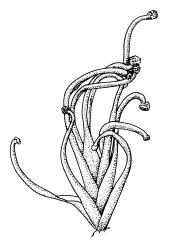- = Syrrhopodon fimbriatulus Müll.Hal., J. Mus. Godeffroy 3: 52 (1874)
Plants small, pale white- or brown-green, forming tufts or sparse turves. Stems simple or sparsely forked, < 2–10 mm, beset below with strongly papillose, brick-red rhizoids, in cross-section lacking a central strand. Leaves strongly curved when dry, straight and ± erect when moist, with a moderately distinct oblong, pale, and sheathing base and a distinct upper lamina (or limb) most obvious when dry, usually appearing swollen at apex because of yellow-green adaxial masses of gemmae, c. 2.5–3.0 × 0.25–0.4 mm, with base c. ⅓ the total length; cancellinae reaching ¼ to nearly ⅓ the leaf length, with hyaline cells oblong, thin-walled, and mostly 45–60 × c. 25–30 µm; margin of the leaf base with 1–3 rows of elongate cells, the outermost bearing many (commonly 10–12) unicellular, patent or sometimes retrorse spines (c. 60–75 µm long), these reduced or lacking in some leaves; the upper lamina (limb) ligulate to narrowly linear, rounded and broadly acute at apex, entire except for a few small crenulations above, often with a small mucro, involute at margin throughout or ± plane in patches, with a narrow and pellucid border c. 8–10 µm and c. 2 cells wide; upper laminal cells (of limb) oblong, firm-walled, unipapillose on both surfaces with tall and conspicuous papillae, mostly c. 10–15 × 6–8 µm, somewhat shorter near apex. Costa strong, subpercurrent, c. 45–60 µm wide at base of limb, scarcely tapered, usually ending in a few pellucid cells to form a small mucro, with conspicuous single-celled abaxial spines. Gemmae borne in yellow-green masses at leaf tip, mostly 4–6-celled and c. 75 × 25 µm.
Presumably dioicous. Sporophytes unknown from N.Z.
Reese & Bartlett 1982, fig. 1, pl. 1 (as S. fimbriatulus); Reese et al. 1986, fig. 67 (as S. fimbriatulus); Eddy 1990, fig. 213, b (as S. fimbriatulus).
Although the dry plants of S. armatus bear some resemblance to species of Tortella, the strongly ciliate basal margins and the well-developed cancellinae make this species unmistakeable among N.Z. mosses.
K (track to Dripping Wells Terraces, Moumoukai Track); NI: N Auckland (Surville Cliffs, Whangaruru North Head) including offshore islands (PK, GB), S Auckland (Hot Water Beach, Pāuanui); Ch (Wairarapa Creek, Rabbit I.).
Palaeotropical. According to Reese & Stone (1995) widespread in northern and eastern Australia (south to Jervis Bay); they also indicate it to be "widespread in the paleotropics".
Fewer than 10 N.Z. specimens have been seen. Three of them occurred on the caudices of tree ferns (two from Cyathea dealbata; one unspecified), and a fourth from decaying "stump of Astelia banksii". The Kermadec Is collections are from trunks of Metrosideros kermadecensis. Collections from Rabbit I. in the Chatham Is and from Aorangi I. in the Poor Knights Is were both associated with petrel burrows, the latter from "bare, compacted humusy soil, sloping in heavily burrowed petrel area; under high, medium dense canopy of pōhutukawa forest". A 2008 collection from Pāuanui, P.J. de Lange 7361 (AK 302195), came from "very dry, coarse, rhyolitic soil, colluvium and rock amongst Picris burbidgeae, Fissidens leptocladus and Trichostomum cf. brachydontium." All known collections are from coastal areas, from sea level to c. 180 m.
The species was first discovered in N.Z. by J.K. Bartlett at Hot Water Beach on the Coromandel Peninsula (S Auckland L.D.).
Reese & Stone (1995) characterised this as "the most common and widespread member of the genus Syrrhopodon in Australia" and noted that "the pale green, glaucous appearance, uncinate-curled leaves mostly with conspicuous cilia on the shoulder, often spinose costae, and unipapillose cells are diagnostic".












